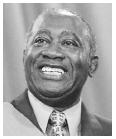CÔTE D'IVOIRE
Laurent Gbagbo
President

(pronounced "low-RAHN BAH-bow")
"We continue to dream of a day where the whole Ivorian society will reconcile with itself."
The République de Côte d'Ivoire (Republic of Ivory Coast) is located in West Africa with a 507 km (315 mi) Gulf of Guinea coastline as its southern border and Liberia and Guinea to the west and northwest, Mali and Burkina Faso to the north and northeast and Ghana to the west. Its area is 322,463 sq km (124,503 sq mi). Three vegetation zones define Côte d'Ivoire: a narrow coastal/lagoon region, a central forest belt covering approximately one-third of the country, and a grassy woodland northern region. There are four major rivers draining north-south into the Gulf of Guinea: the Comoe, the Bandama, the Sassandra, and the Cavally (moving from east to west). They are only navigable a short distance from the coast due to rapids created by the primarily southward-sloping plateau nature of the Ivoirian topography.
Côte d'Ivoire's population is approximately 16.8 million. Average life expectancy at birth has dropped to 45 years (2002), and will be affected by the HIV/AIDS adult prevalence rate, which was 10.76% in 1999. The population growth rate, once one of the highest in the world at 3.8%, decreased by 2002 to 2.45%. The population is not evenly distributed; the northeast and southwest have very low population densities.
Over 60 ethnic groups, each with its own language has made the country highly pluralistic. The major ethnic/language groupings are the Akan, Voltaiques or Gur, Northern Mande, Kru (Krous), and Southern Mande. The official language of the country is French. Approximately one-third of the population is foreign, with a 6% annual rate of immigration. Côte d'Ivoire has one of the largest French communities in Africa, numbering approximately 30,000 in 1999. There is also a substantial Lebanese population (estimated variously between 100,00 to 300,000) living mostly in the urban areas of the country. About 20–30% of the population identifies itself as Christian, 35–40% as Muslim, and 25–40% as practitioners of indigenous religions (mostly animist). The literacy rate was 48.5% in 2001.
Yamoussoukro is the official political capital of the country, but the economic capital and most of the government offices remain in the former capital of Abidjan, which has experienced rapid population growth at 3.3 million (2002 estimate). The Ivoirian unit of currency is the Communauté Financière Africaine franc (CFA franc ). The per capita gross national product (GNP) was US $1,550 (2001). Cocoa, coffee, cotton, bananas, palm oil and kernels, pineapple, and rubber dominate exports and more than half of the country's export revenues came from coffee and cocoa products in 2000. Timber exports have fallen greatly due to over–harvesting. Cotton production has increased and the country is now third in cotton production for African countries. Expanding rubber production is another healthy sign in the diversification of the Ivoirian economy. In food crops, Côte d'Ivoire is self-sufficient in cassava, yams, plantains, and maize. It produces 40% of the meat that its population consumes.
ADDRESS
Présidence de la République de Côte d'Ivoire
Yamoussoukro
Côte d'Ivoire
Comment about this article, ask questions, or add new information about this topic: